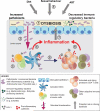The gut microbiome and HIV-1 pathogenesis: a two-way street
- PMID: 27755100
- PMCID: PMC5101180
- DOI: 10.1097/QAD.0000000000001289
The gut microbiome and HIV-1 pathogenesis: a two-way street
Abstract
HIV-1 infection is associated with substantial damage to the gastrointestinal tract resulting in structural impairment of the epithelial barrier and a disruption of intestinal homeostasis. The accompanying translocation of microbial products and potentially microbes themselves from the lumen into systemic circulation has been linked to immune activation, inflammation, and HIV-1 disease progression. The importance of microbial translocation in the setting of HIV-1 infection has led to a recent focus on understanding how the communities of microbes that make up the intestinal microbiome are altered during HIV-1 infection and how they interact with mucosal immune cells to contribute to inflammation. This review details the dysbiotic intestinal communities associated with HIV-1 infection and their potential link to HIV-1 pathogenesis. We detail studies that begin to address the mechanisms driving microbiota-associated immune activation and inflammation and the various treatment strategies aimed at correcting dysbiosis and improving the overall health of HIV-1-infected individuals. Finally, we discuss how this relatively new field of research can advance to provide a more comprehensive understanding of the contribution of the gut microbiome to HIV-1 pathogenesis.
Figures


Similar articles
-
Microbial translocation and microbiome dysbiosis in HIV-associated immune activation.Curr Opin HIV AIDS. 2016 Mar;11(2):182-90. doi: 10.1097/COH.0000000000000234. Curr Opin HIV AIDS. 2016. PMID: 26679414 Free PMC article. Review.
-
Contribution of the Microbiota to Intestinal Homeostasis and its Role in the Pathogenesis of HIV-1 Infection.Curr HIV Res. 2019;17(1):13-25. doi: 10.2174/1570162X17666190311114808. Curr HIV Res. 2019. PMID: 30854974 Review.
-
Gut barrier structure, mucosal immunity and intestinal microbiota in the pathogenesis and treatment of HIV infection.AIDS Res Ther. 2016 Apr 11;13:19. doi: 10.1186/s12981-016-0103-1. eCollection 2016. AIDS Res Ther. 2016. PMID: 27073405 Free PMC article. Review.
-
Low abundance of colonic butyrate-producing bacteria in HIV infection is associated with microbial translocation and immune activation.AIDS. 2017 Feb 20;31(4):511-521. doi: 10.1097/QAD.0000000000001366. AIDS. 2017. PMID: 28002063 Free PMC article.
-
Altered gut microbiome composition in HIV infection: causes, effects and potential intervention.Curr Opin HIV AIDS. 2018 Jan;13(1):73-80. doi: 10.1097/COH.0000000000000429. Curr Opin HIV AIDS. 2018. PMID: 29045252 Review.
Cited by
-
Early changes in the gut microbiome among HIV-infected Individuals in Uganda initiating daily TMP/SMX.medRxiv [Preprint]. 2024 Oct 7:2024.10.07.24315002. doi: 10.1101/2024.10.07.24315002. medRxiv. 2024. PMID: 39417122 Free PMC article. Preprint.
-
HIV-associated neurocognitive disorder: key implications of the microbiota-gut-brain axis.Front Microbiol. 2024 Aug 2;15:1428239. doi: 10.3389/fmicb.2024.1428239. eCollection 2024. Front Microbiol. 2024. PMID: 39155987 Free PMC article. Review.
-
Major depletion of insulin sensitivity-associated taxa in the gut microbiome of persons living with HIV controlled by antiretroviral drugs.BMC Med Genomics. 2024 Aug 13;17(1):209. doi: 10.1186/s12920-024-01978-5. BMC Med Genomics. 2024. PMID: 39138568 Free PMC article.
-
Alterations in the Gut Microbiome Composition of People Living with HIV in the Asia-Pacific Region: A Systematic Review.Clin Pract. 2024 May 15;14(3):846-861. doi: 10.3390/clinpract14030066. Clin Pract. 2024. PMID: 38804398 Free PMC article. Review.
-
Latent tuberculosis infection is associated with an enrichment of short chain fatty acid producing bacteria in the stool of women living with HIV.Res Sq [Preprint]. 2024 Apr 2:rs.3.rs-4182285. doi: 10.21203/rs.3.rs-4182285/v1. Res Sq. 2024. Update in: Microorganisms. 2024 May 22;12(6):1048. doi: 10.3390/microorganisms12061048. PMID: 38645218 Free PMC article. Updated. Preprint.
References
-
- Chege D, Sheth PM, Kain T, Kim CJ, Kovacs C, Loutfy M, et al. Sigmoid Th17 populations, the HIV latent reservoir, and microbial translocation in men on long-term antiretroviral therapy. AIDS. 2011;25:741–749. - PubMed
-
- Guadalupe M, Reay E, Sankaran S, Prindiville T, Flamm J, McNeil A, et al. Severe CD4+ T-cell depletion in gut lymphoid tissue during primary human immunodeficiency virus type 1 infection and substantial delay in restoration following highly active antiretroviral therapy. J Virol. 2003;77:11708–11717. - PMC - PubMed
-
- Sankaran S, George MD, Reay E, Guadalupe M, Flamm J, Prindiville T, et al. Rapid onset of intestinal epithelial barrier dysfunction in primary human immunodeficiency virus infection is driven by an imbalance between immune response and mucosal repair and regeneration. J Virol. 2008;82:538–545. - PMC - PubMed
Publication types
MeSH terms
Grants and funding
LinkOut - more resources
Full Text Sources
Other Literature Sources
Medical

